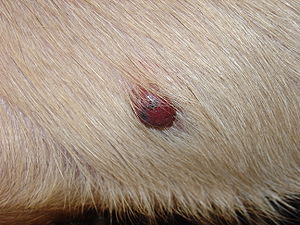This is a relatively common cancer that can occur. We see a fair number of sick dogs come into the Animal Hospital of Polaris with this condition, most of the time with the owner completely unsuspecting of the seriousness of this disease.
It is frustrating because often the first sign that dogs have this problem is when they collapse – and by then, the condition is already life threatening.
Hemangiosarcoma is a malignant cancer of the cells that form blood vessels. Because these tumors start in blood vessels, they are frequently filled with blood. Consequently, when a blood-filled tumor ruptures, it can cause problems with internal or external bleeding.
It comes on fast. Often the first sign of a problem is a dog that was fine – never appearing sick – and then suddenly the dog just collapses.
Hemangiosarcoma is considered to be a very aggressive tumor and it can spread rapidly to other organs. It occurs in middle-aged to older dogs 9 to 11 years of age, and German shepherds appear to be predisposed to developing this cancer.
The most common primary location of this cancer in dogs is the spleen.
Signs of this disease are usually the result of the tumor rupturing, which causes bleeding. This may occur without any warning, and the symptoms will depend upon where the tumor is located. When a tumor in the spleen or liver ruptures, the signs are usually due to bleeding into the abdomen. This causes anemia, weakness and, if the bleeding is severe, collapse. The dog’s gums may appear to be pale or white.
In relatively few animals the diagnosis is made before the tumor ruptures. It is frustrating and heart wrenching. Many dogs do not survive and the progression of the disease is rapid.
If your dog collapses, take a look at his gums. Are they pale? Does he seem weak? If you suspect any of these symptoms, call us immediately at (614)888-4050. Surgery can be done to help identify these tumors.
Related articles
Hemangiosarcoma (dogfyi.com)

No comments:
Post a Comment